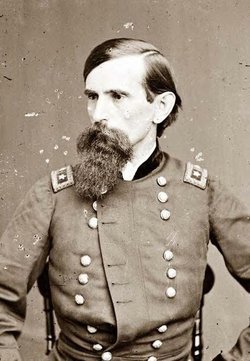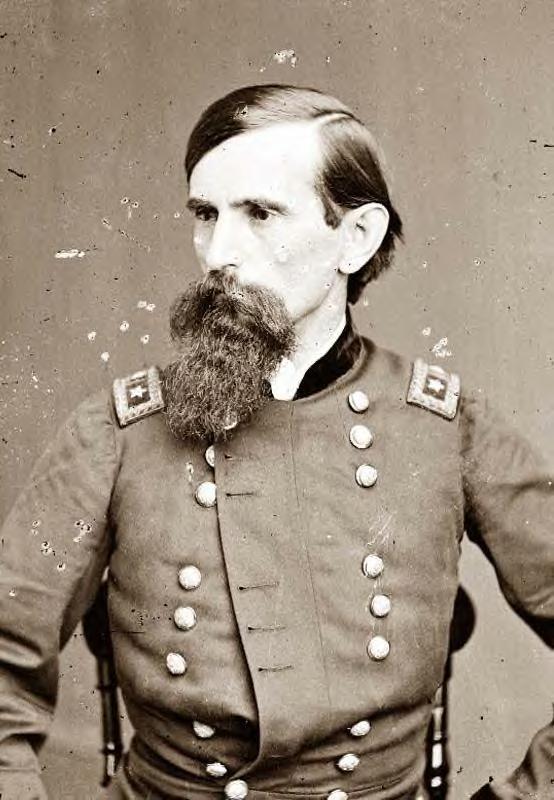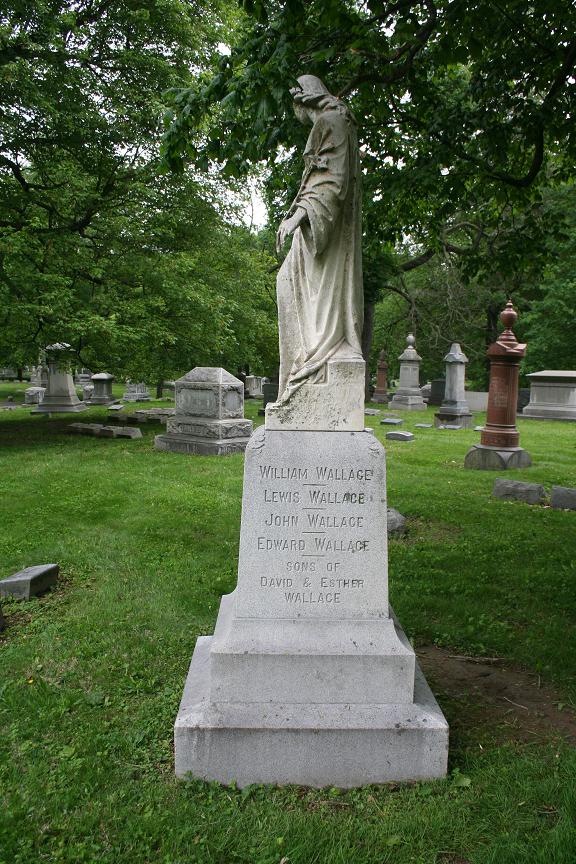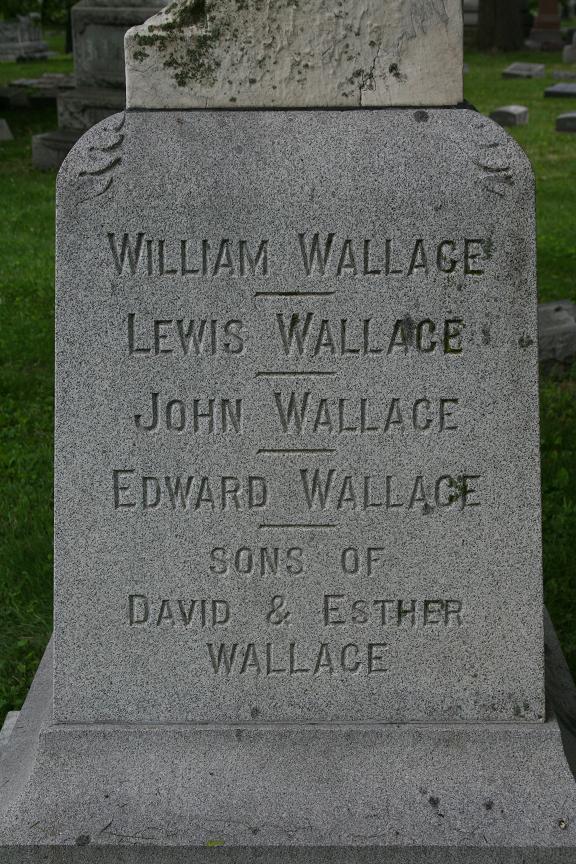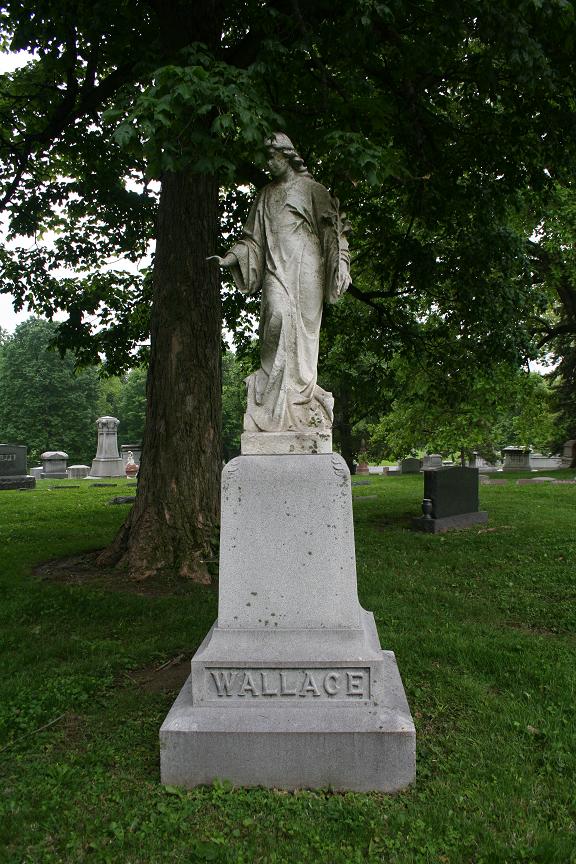Politician, American Civil War Major General, New Mexico Territorial Governor, Diplomat, and Author. He is best remembered for his historical novel "Ben-Hur: A Tale of the Christ" (1880), a bestselling book since its publication, and deemed by many as the most influential Christian book of the nineteenth century. His father was a graduate of the US Military Academy at West Point, New York and served as lieutenant governor and governor of Indiana. When he was seven years old his mother died and two years later, he joined his brother in Crawfordsville, Indiana where he briefly attended Wabash Preparatory School before rejoining his father in Indianapolis, Indiana. In 1846, at the start of the Mexican American War, he was studying law and set it aside to raise a company of militia and was elected a 2nd lieutenant in the 1st Indiana Infantry regiment. He rose to the position of regimental adjutant and the rank of 1st lieutenant, serving in the army of General Zachary Taylor, although he personally did not participate in combat. After the war, he and William B. Greer operated a Free-Soil newspaper, The Free-Soil Banner, in Indianapolis. In 1849 he was admitted to the bar and established a law practice in Indianapolis with his older brother William. He relocated to Covington and won election as prosecuting attorney of Indiana's 1st congressional district. He moved to Crawfordsville in 1853 and in 1856, he won election as a Democrat to the Indiana State Senate. The same year he organized a militia unit in Crawfordsville called the Montgomery Guards, which would form the basis of his first Civil War regiment, the 11th Indiana Volunteer Infantry. Prior to the start of the American Civil War e joined the Republican Party and when the war broke out, Indiana's Republican governor Oliver P. Morton asked him to help raise troops and he agreed on the condition that he be given command of a regiment. He was appointed state adjutant general and in April 1861 he was appointed colonel of the 11th Indiana Infantry. After reading about elite units of the French Army he decided to train and outfit his men as Zouaves. In June 1861, while stationed at Cumberland, Maryland, his regiment won a minor battle at Romney, West Virginia and the following September he was promoted to the rank of brigadier general of volunteers and given the command of a brigade. In February 1862 he was engaged in combat at Forts Henry and Donelson in Tennessee and the following month he was promoted to the rank of major general of volunteers. His most controversial command came at the Battle of Shiloh in Tennessee, where he continued as the 3rd Division commander under Major General Ulysses S. Grant, when he took the wrong route to reach Shiloh Church, where the Union forces were being attacked by Confederate forces under General Albert Sidney Johnston. Initially, there was little fallout from this as he was the youngest general of his rank in the Union Army and was something of a "golden boy". However, when civilians in the North began to hear the news of the horrible casualties at Shiloh, they demanded explanations. Both Grant and his superior, General Henry Halleck, placed the blame squarely on Wallace, saying that his incompetence in moving up the reserves had nearly cost them the battle. He was removed from his command the following June and reassigned to command the defense of Cincinnati in the Department of the Ohio during Braxton Bragg's incursion into Kentucky. In July 1864 at the Battle of Monocacy in Maryland, he was able to delay General Jubal A. Early's advance (although he lost the battle) toward Washington DC for an entire day, giving the city defenses time to organize and repel Early. General Grant relieved him of his command after learning of his defeat at Monocacy but reinstated him two weeks later. Grant's memoirs of the war praised his delaying tactics at Monocacy. He participated in the military commission trial of the Lincoln assassination conspirators, as well as the court-martial of Henry Wirz, the commandant in charge of the notorious Confederate Andersonville prison camp. In November 1865 he resigned from the US Army and was offered a major general's commission in the Mexican army, to help expel the French. Multiple promises by the Mexicans were never fulfilled, and he ended up incurring deep financial debt. In 1878 he was appointed governor of New Mexico Territory, serving until 1881. As governor he offered amnesty to many men involved in the Lincoln County War, an Old West range war between two factions over the control of the dry goods trade in the county. In the process he met with the outlawed William Henry McCarty (also known as Billy the Kid) and in March 1879, the pair arranged that the Kid would act as an informant and testify against others involved in the Lincoln County War and, it has been claimed, that in return the Kid would receive a pardon. According to this account, Wallace, facing the political forces then ruling New Mexico, was unable to come through on his end of the bargain and the Kid returned to his outlaw ways. It was during this time that he penned his most noted novel, "Ben-Hur: A Tale of the Christ." It became the best-selling American novel of the 19th century, surpassing Harriet Beecher Stowe's "Uncle Tom's Cabin" (1852). In 1881 he was appointed the US Minister to the Ottoman Empire serving in that position until 1885. When the US declared war on Spain in 1898, he offered to raise and lead a division of soldiers but was turned down and when he attempted to enlist as a private, he was rejected due to his age. He died from atrophic gastritis at the age of 77. His other works include "The Fair God; or The Last of the 'Tzins: A Tale of the Conquest of Mexico" (1873), "The Boyhood of Christ" (1888), "Life of Gen. Ben Harrison" (1888), "The Prince of India; or Why Constantinople Fell" (1893, two volumes), and "Lew Wallace: An Autobiography" (1906, two volumes). A statue in his honor resides in the National Statuary Hall Collection in the US Capitol. His writing study, adjacent to his residence in Crawfordsville is now called the General Lew Wallace Study & Museum and was designated a National Historic Landmark and open to the public. His "Ben Hur" has never been out of print and has been adapted into films four times, the latest one being MGM's 1959 production starring Charlton Heston, that won 11 Academy Awards in 1960.
Politician, American Civil War Major General, New Mexico Territorial Governor, Diplomat, and Author. He is best remembered for his historical novel "Ben-Hur: A Tale of the Christ" (1880), a bestselling book since its publication, and deemed by many as the most influential Christian book of the nineteenth century. His father was a graduate of the US Military Academy at West Point, New York and served as lieutenant governor and governor of Indiana. When he was seven years old his mother died and two years later, he joined his brother in Crawfordsville, Indiana where he briefly attended Wabash Preparatory School before rejoining his father in Indianapolis, Indiana. In 1846, at the start of the Mexican American War, he was studying law and set it aside to raise a company of militia and was elected a 2nd lieutenant in the 1st Indiana Infantry regiment. He rose to the position of regimental adjutant and the rank of 1st lieutenant, serving in the army of General Zachary Taylor, although he personally did not participate in combat. After the war, he and William B. Greer operated a Free-Soil newspaper, The Free-Soil Banner, in Indianapolis. In 1849 he was admitted to the bar and established a law practice in Indianapolis with his older brother William. He relocated to Covington and won election as prosecuting attorney of Indiana's 1st congressional district. He moved to Crawfordsville in 1853 and in 1856, he won election as a Democrat to the Indiana State Senate. The same year he organized a militia unit in Crawfordsville called the Montgomery Guards, which would form the basis of his first Civil War regiment, the 11th Indiana Volunteer Infantry. Prior to the start of the American Civil War e joined the Republican Party and when the war broke out, Indiana's Republican governor Oliver P. Morton asked him to help raise troops and he agreed on the condition that he be given command of a regiment. He was appointed state adjutant general and in April 1861 he was appointed colonel of the 11th Indiana Infantry. After reading about elite units of the French Army he decided to train and outfit his men as Zouaves. In June 1861, while stationed at Cumberland, Maryland, his regiment won a minor battle at Romney, West Virginia and the following September he was promoted to the rank of brigadier general of volunteers and given the command of a brigade. In February 1862 he was engaged in combat at Forts Henry and Donelson in Tennessee and the following month he was promoted to the rank of major general of volunteers. His most controversial command came at the Battle of Shiloh in Tennessee, where he continued as the 3rd Division commander under Major General Ulysses S. Grant, when he took the wrong route to reach Shiloh Church, where the Union forces were being attacked by Confederate forces under General Albert Sidney Johnston. Initially, there was little fallout from this as he was the youngest general of his rank in the Union Army and was something of a "golden boy". However, when civilians in the North began to hear the news of the horrible casualties at Shiloh, they demanded explanations. Both Grant and his superior, General Henry Halleck, placed the blame squarely on Wallace, saying that his incompetence in moving up the reserves had nearly cost them the battle. He was removed from his command the following June and reassigned to command the defense of Cincinnati in the Department of the Ohio during Braxton Bragg's incursion into Kentucky. In July 1864 at the Battle of Monocacy in Maryland, he was able to delay General Jubal A. Early's advance (although he lost the battle) toward Washington DC for an entire day, giving the city defenses time to organize and repel Early. General Grant relieved him of his command after learning of his defeat at Monocacy but reinstated him two weeks later. Grant's memoirs of the war praised his delaying tactics at Monocacy. He participated in the military commission trial of the Lincoln assassination conspirators, as well as the court-martial of Henry Wirz, the commandant in charge of the notorious Confederate Andersonville prison camp. In November 1865 he resigned from the US Army and was offered a major general's commission in the Mexican army, to help expel the French. Multiple promises by the Mexicans were never fulfilled, and he ended up incurring deep financial debt. In 1878 he was appointed governor of New Mexico Territory, serving until 1881. As governor he offered amnesty to many men involved in the Lincoln County War, an Old West range war between two factions over the control of the dry goods trade in the county. In the process he met with the outlawed William Henry McCarty (also known as Billy the Kid) and in March 1879, the pair arranged that the Kid would act as an informant and testify against others involved in the Lincoln County War and, it has been claimed, that in return the Kid would receive a pardon. According to this account, Wallace, facing the political forces then ruling New Mexico, was unable to come through on his end of the bargain and the Kid returned to his outlaw ways. It was during this time that he penned his most noted novel, "Ben-Hur: A Tale of the Christ." It became the best-selling American novel of the 19th century, surpassing Harriet Beecher Stowe's "Uncle Tom's Cabin" (1852). In 1881 he was appointed the US Minister to the Ottoman Empire serving in that position until 1885. When the US declared war on Spain in 1898, he offered to raise and lead a division of soldiers but was turned down and when he attempted to enlist as a private, he was rejected due to his age. He died from atrophic gastritis at the age of 77. His other works include "The Fair God; or The Last of the 'Tzins: A Tale of the Conquest of Mexico" (1873), "The Boyhood of Christ" (1888), "Life of Gen. Ben Harrison" (1888), "The Prince of India; or Why Constantinople Fell" (1893, two volumes), and "Lew Wallace: An Autobiography" (1906, two volumes). A statue in his honor resides in the National Statuary Hall Collection in the US Capitol. His writing study, adjacent to his residence in Crawfordsville is now called the General Lew Wallace Study & Museum and was designated a National Historic Landmark and open to the public. His "Ben Hur" has never been out of print and has been adapted into films four times, the latest one being MGM's 1959 production starring Charlton Heston, that won 11 Academy Awards in 1960.
Bio by: William Bjornstad
Family Members
-
![]()
William Wallace
1825–1891
-
![]()
Lewis "Lew" Wallace
1827–1905
-
John Test Wallace
1829–1832
-
![]()
CPT Edward Test Wallace
1831–1885
-
![]()
Mary Sanders Wallace Leathers
1837–1871
-
![]()
Ellen S Wallace
1845–1846
-
![]()
Agnes Wallace Steiner
1848–1928
-
![]()
David "Dave" Wallace
1852–1911
-
![]()
Jemima Sanders Wallace
1854–1866
-
![]()
Sanders Wallace
1857–1858
Advertisement
See more Wallace memorials in:
Records on Ancestry
Advertisement
